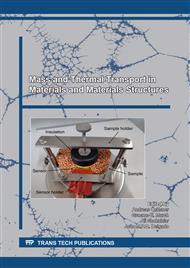[1]
G.K. Malikov, D.L. Lobanov, K.Y. Malikov, V.G. Lisienko, R. Viskanta, A.G. Fedorov, Direct flame impingement heating for rapid thermal materials processing. Int. J. Heat Mass Transf. 44(9) (2001) 1751–1758.
DOI: 10.1016/s0017-9310(00)00204-0
Google Scholar
[2]
G. Malikov, V. Lisienko, Y. Malikov, J. Wagner, H. Kurek, Y. Chudnovsky, R. Viskanta, Mathematical modeling of direct flame impingement heat transfer, in: Proceedings of the ASME 2006 International Mechanical Engineering Congress and Exposition, ASME, 2007, pp.615-623.
DOI: 10.1115/imece2006-13472
Google Scholar
[3]
L.K. Farmer, M.D. Lanyi, J.S. Becker and C.A. Ward, U.S. Patent 5,688,339 (1997).
Google Scholar
[4]
M.G. Carvalho, M. Nogueira, Improvement of energy efficiency in glass-melting furnaces, cement kilns and baking oven, Appl. Therm. Eng. 17(8-10) (1997) 921-933.
DOI: 10.1016/s1359-4311(97)00001-x
Google Scholar
[5]
T. Morgado, P.J. Coelho, P. Talukdar, Assessment of uniform temperature assumption in zoning on the numerical simulation of a walking beam reheating furnace, Appl. Therm. Eng. 76 (2015) 496–508.
DOI: 10.1016/j.applthermaleng.2014.11.054
Google Scholar
[6]
L. Ljung, Black-box models from input-output measurements, in: Proceedings of the 18th IEEE Instrumentation and Measurement Technology Conference. Rediscovering Measurement in the Age of Informatics, IEEE, 2001, Vol. 1, pp.138-146.
DOI: 10.1109/imtc.2001.928802
Google Scholar
[7]
D.F. Staalman, A. Kusters, On-line slab temperature calculation and control, J. Manuf. Sci. Eng. 4 (1996) 307-314.
Google Scholar
[8]
P. Laurinen, J. Röning, An adaptive neural network model for predicting the post roughing mill temperature of steel slabs in the reheating furnace, J Mater. Process. Technol. 168(3) (2005) 423-430.
DOI: 10.1016/j.jmatprotec.2004.12.002
Google Scholar
[9]
Y. Liao, M. Wu, J.H. She, Modeling of reheating-furnace dynamics using neural network based on improved sequential-learning algorithm, in: Proceedings of the 2006 IEEE Conference on Computer Aided Control System Design, 2006 IEEE International Conference on Control Applications, 2006 IEEE International Symposium on Intelligent Control, IEEE, Munich, 2006, pp.3175-3181.
DOI: 10.1109/cacsd-cca-isic.2006.4777146
Google Scholar
[10]
C. Pepe, S.M. Zanoli, F. Cocchioni, Energy saving and environmental impact decreasing in a walking beam reheating furnace, WIT Tran. Ecol. Environ. 205 (2016) 135-146.
DOI: 10.2495/eq160131
Google Scholar
[11]
D.R. Kreuzer, A. Werner, Implementation of models for reheating processes in industrial furnaces, in: Proceedings of the 8th International Modelica Conference, Linköping University Electronic Press, Linköping, 2011, no. 063, pp.376-387.
DOI: 10.3384/ecp11063376
Google Scholar
[12]
Y. Hu, C.K. Tan, J. Broughton, P.A. Roach, L. Varga, Nonlinear dynamic simulation and control of large-scale reheating furnace operations using a zone method based model, Appl. Therm. Eng. 135 (2018) 41-53.
DOI: 10.1016/j.applthermaleng.2018.02.022
Google Scholar
[13]
W. Trinks, M.H. Mawhinney, R.A. Shannon, R.J. Reed, J.R. Garvey, Industrial Furnaces, sixth ed., John Wiley & Sons, Inc., New Jersey, (2004).
DOI: 10.1002/9780470172612
Google Scholar
[14]
Information on http://www.ansys.com/products/fluids/ansys-fluent.
Google Scholar
[15]
J.P. Vandoormaal, G.D. Raithby, Enhancements of the SIMPLE method for predicting incompressible fluid flows, Numer. Heat Transf. 7 (1984) 147-163.
DOI: 10.1080/01495728408961817
Google Scholar
[16]
T.H. Shih, W.W. Liou, A. Shabbir, Z. Yang, J. Zhu, A new k-ε eddy viscosity model for high Reynolds number turbulent flows, Comput. Fluids 24(3) (1995) 227-238.
DOI: 10.1016/0045-7930(94)00032-t
Google Scholar
[17]
G.D. Raithby, E.H. Chui, A finite-volume method for predicting a radiant heat transfer in enclosures with participating media, J. Heat Transf. 112 (1990) 415-423.
DOI: 10.1115/1.2910394
Google Scholar
[18]
E.H. Chui, G.D. Raithby, Computation of radiant heat transfer on a non-orthogonal mesh using the finite-volume method, Numer. Heat Transf. B 23 (1993) 269-288.
DOI: 10.1080/10407799308914901
Google Scholar
[19]
B. Jenkins, P. Mullinger, Industrial and Process Furnaces: Principles, Design and Operation, second ed., Butterworth-Heinemann, Oxford, (2014).
Google Scholar


